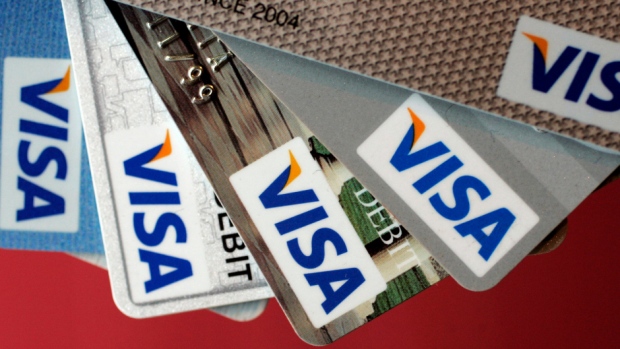Apr 20, 2017
Visa reports 27% profit increase; to buy back up to US$5B in shares
, Reuters

Visa Inc (V.N) on Thursday reported better-than-expected quarterly earnings and said it expects full-year profit at the high end of its forecast, as it benefits from the purchase of Visa Europe and big credit-card portfolio wins back home.
Shares of Visa, the world's largest payments network operator, were up 2.5 per cent at US$93.45 in trading after the bell, after it also announced a US$5 billion share buyback program.
The company said total payments volume jumped 37.2 per cent to US$1.73 trillion in the second quarter ended March 31, on a constant dollar basis.
San Francisco-based Visa, like rival Mastercard (MA.N), generates revenue by facilitating credit- and debit-card transactions.
The growth in payments volume was helped by the addition to Visa's results of Visa Europe, a former subsidiary Visa bought in June last year in a deal worth as much as US$23 billion.
Visa Europe made up nearly a fifth of total payments volume.
Payments volume in the United States, Visa's biggest market, increased 11.7 per cent on a constant dollar basis, helped both by major portfolio contracts as well as a stronger economy.
Warehouse club retailer Costco and USAA, one of the largest U.S. issuers of credit and debit cards, switched their card portfolios to Visa last year, in a competitive environment where large portfolios are hotly sought-after by payment networks.
A healthier U.S. economy, which has seen strong jobs growth and rising incomes in the first quarter of 2017, bodes well for consumer spending W a key economic indicator for payments processors like Visa.
The trends, while boosting quarterly profit and revenue, also helped Visa update its full-year forecast. The company now expects adjusted profit at the high end of its forecast for a mid-teens percentage point increase.
Visa also said it expects full-year revenue at the high end of its forecast for a 16-18 per cent increase.
Net income fell to US$430 million or 18 cents US per Class A share in the second quarter, from US$1.71 billion or 71 cents US per Class A share, a year earlier, reflecting a US$1.5 billion one-time charge related to Visa Europe.
Excluding one-time items, Visa earned 86 cents US per Class A share, beating analysts' average estimate of 79 cents US, according to Thomson Reuters I/B/E/S.
Net operating revenue rose 23.5 per cent to US$4.48 billion. Analysts on average had expected US$4.29 billion.
Visa's stock, a Dow component, had climbed 12.3 per cent in the 12 months through Thursday.




